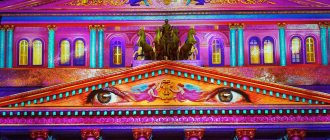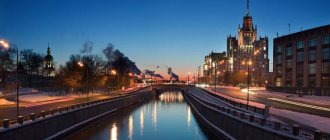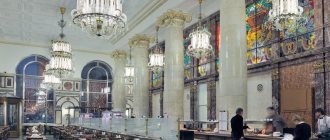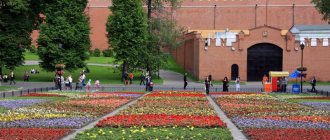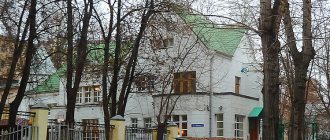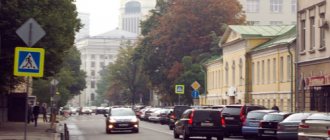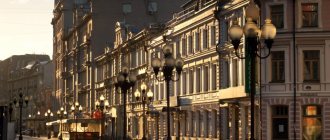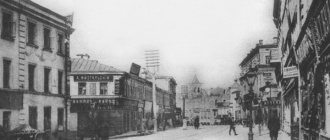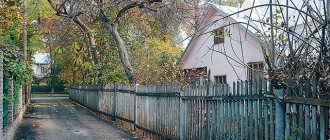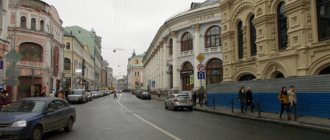| Plyushchikha Street | |
| View from the middle of Plyushchikha towards Smolenskaya Square | |
| general information | |
| A country | Russia |
| City | Moscow |
| District | Central Administrative District |
| Area | Khamovniki |
| Length | 1.2 km |
| Metro | 04 Smolenskaya (300 m.) |
| Former names | Smolenskaya street, Savvinskaya street |
| Postcode | 119121 |
| Phone numbers | +7 (499) XXX—- |
| Plyushchikha Street at Wikimedia Commons | |
Plyushchikha Street
is a street in the Khamovniki district of the Central Administrative District of Moscow. Runs from Smolenskaya Street to 2nd Truzhenikov Lane. The numbering of houses starts from Smolenskaya Street.
Story
The history of the street begins in the 15th century, when the courtyard of the Rostov bishop was located along the road to Smolensk (numerous Rostov lanes remind of this). Until the end of the 16th century, the road to Smolensk (leading to the Crimean Ford on the Moscow River) passed along Plyushchikha, so before that it was called Smolenskaya Street, and even earlier - Savvinskaya, named after the Savvinsky Monastery located at the end of the street.
At the end of the 16th century, a new bridge was built and the road to Smolensk went through the village of Dorogomilovo, along the current direction of Smolenskaya and Bolshaya Dorogomilovskaya streets. And Plyushchikha, by the end of the 17th century, got its name - in honor of Plyushchev’s tavern, which opens at the beginning of the street.
Until the 17th century, the territory between Plyushchikha and the Moscow River was called Dorogomilov, but by the end of the century settlements were formed around the compound of the Rostov bishop. On the western side of the street is Blagoveshchenskaya (or Berezhkovskaya) - belonging to the Rostov Metropolitan, on the eastern side - the palace Ruzheinaya (the name of Ruzheyny Lane reminds of it), where the masters from the Armory Chamber lived), as well as the royal New Konyushenny Dvor (Novokonyushenny Lane).
In 1649, the properties behind the earthen rampart were formally transferred to the city, but most of them remained with the previous owners, who traded the land and were actively building. In the notes of 1790 on the western side of Plyushchikha there is no longer one owner - the Rostov bishop, but two - “people of different ranks”.
Along the modern Vrazhsky lanes, the Litter Vrazhek is formed - horse manure was transported there from the Konyushenny yard.
Plyushchikha survived the Moscow fire of 1812 with losses, but the western part of the street was almost undamaged, only two houses burned out.
According to the records of 1850, there were already 26 courtyards on the eastern side of the street, and 27 on the western side. There were stone buildings in only 18 courtyards; the properties belonged mainly to petty officials and merchants. At the corner of Plyushchikha and Smolenskaya streets there was a church of the Smolensk Icon of the Virgin Mary; in the building built in front of it there was a tavern, popular among visitors to the Smolensk market.
By 1852, there were already 31 courtyards on the western side, four of which belonged to officials, two to the church and its sexton, 25 to merchants, three to the burghers and one to a “free artist.”
Plyushchikha street
Plyushchikha is an ancient Moscow street located in the Khamovniki district of the Central Administrative District of Moscow near Smolenskaya Square between the Moskva River and the Garden Ring.
Plyushchikha Street starts from Smolenskaya Street, inconspicuously emerging onto it to the right of the Golden Ring Hotel, and ends at the intersection with 2nd Tpuzhenikov Lane. The numbering of houses is from Smolenskaya Street.
The history of the street begins in the 15th century, when the courtyard of the Rostov bishop was located along the road to Smolensk (numerous Rostov lanes remind of this). Until the end of the 15th century, the road to Smolensk (leading to the Crimean Ford on the Moscow River) passed along Plyushchikha, so before that it was called Smolenskaya Street, and even earlier - Savvinskaya, named after the Savvinsky Monastery located at the end of the street.
At the end of the 16th century, a new bridge was built and the road to Smolensk went through the village of Dorogomilovo, along the current direction of Smolenskaya and Bolshaya Zhorogomilovskaya streets. And by the end of the 17th century Plyushchikha got its name - in honor of Plyushchev’s tavern, which opens at the beginning of the street.
Until the 17th century, the territory between Plyushchikha and the Moscow River was called Dorogomilov, but by the end of the century, settlements were formed around the courtyard of the Rostov bishop. On the western side of the street is Blagoveshchenskaya (or Berezhkovskaya) - belonging to the Rostov Metropolitan, on the eastern side - the palace Ruzheinaya (the name of Ruzheyny Lane reminds of it), where the masters from the Armory Chamber lived), as well as the royal New Konyushenny Dvor (Novokonyushenny Lane).
In 1649, the properties behind the earthen rampart were formally transferred to the city, but most of them remained with the previous owners, who traded the land and were actively building. In the notes of 1790 on the western side of Plyushchikha there is no longer one owner - the Rostov bishop, but two - “people of different ranks”.
Along the modern Vrazhsky lanes, the Litter Vrazhek is formed - horse manure was transported there from the Konyushenny yard.
Plyushchikha survived the Moscow fire of 1812 with losses, but the western part of the street was almost undamaged, only two houses burned out.
According to the records of 1850, there were already 26 courtyards on the eastern side of the street, and 27 on the western side. There were stone buildings in only 18 courtyards; the properties belonged mainly to petty officials and merchants. At the corner of Plyushchikha and Smolenskaya streets there was a church of the Smolensk Icon of the Virgin Mary; in the building built in front of it there was a tavern, popular among visitors to the Smolensk market.
By 1852, there were already 31 courtyards on the western side, four of which belonged to officials, two to the church and its sexton, 25 to merchants, three to the burghers and one to a “free artist.”
At the beginning of 1837, the Tolstoy family settled in house 11 on Plyushchikha (Shcherbachev’s house). Lev Nikolaevich was eight years old. However, in the summer of 1837 his father died, and a year later the family moved to Bolshoi Kakovinsky Lane. On Plyushchikha, the Tolstoys occupied a stone house in the courtyard of the property, separated from the street by a wooden fence.
In the 1840s, Professor A.O. lived in the house. Armfeld, who visited here the Aksakovs, M.P. Pogodin and N.V. Gogol. The house has survived to this day; now it houses the 6th department of the Moscow traffic police on a special highway.
On Plyushchikha they lived: in house 32 - the Tolstoyan F.A. Strakhov, in house 36 - the poet A.A. Fet, in house 20 (Akhmatov's house) lived the famous Russian artist V.M. Surikov. In 1867, the writer I.I. Lazhechnikov lived in house 23, the artist S.V. Ivanov lived in house 28, and the artist S.V. Malyutin lived in house 43. None of these houses have survived.
House 62 belonged to the founder of Soviet gynecology, Professor V.F. Snegirev.
In the lane next to Plyushchikha Dolg (now Burdenko Street) lived the famous neurosurgeon N.N. Burdenko.
BUILDING:
On the odd side:
- No. 11 - Apartment building (1900, architect S.V. Sokolov)
- No. 31 - Apartment building of M. G. Shcherbakova (1912, architect N. S. Kurdyukov)
- No. 37 - Apartment house of A. O. Lepenin (1903, architect V.V. Shaub)
- No. 53/25 - Apartment building A. L. Baumgarten (1913-1914, architect N. M. Chelishchev)
- No. 55 - Apartment building (1913, architect G.L. Otrazhevsky)
- No. 57 - Burevestnik stadium.
On the even side:
- No. 10 - Nikolaev House of the Brotherly Loving Society (1897-1899, architect I.P. Mashkov). In 1996-1997 it was reconstructed according to the design of A.R. Asadov.
- No. 22 - Residential building (2000, Pavel Andreev Architectural Studio), winner of the competition for the best completed project in 2000. Built on the site of a demolished apartment building (1912, architect G.P. Evlanov)
- No. 26 - Apartment building of V.V. Kiselyov (1913, architect A.F. Meisner)
- No. 42 – Residential building (1973, studio of architect E.N. Stamo)
- No. 56 - Embassy of the Republic of Korea.
- No. 62 - Mansion of Professor V.F. Snegirev (1893-1894, architect R.I. Klein)
- No. 64 - Club (1929, architect K.S. Melnikov)
Friday, January 24, 2014, 8:49 pm.
1742 views.
Permalink
Reply Subscribe
Famous residents of Plyushchikha
At the beginning of 1837, the Tolstoy family settled in house 11 on Plyushchikha (Shcherbachev’s house). Lev Nikolaevich was eight years old. However, in the summer of 1837 his father died, and a year later the family moved to Bolshoi Kakovinsky Lane. On Plyushchikha, the Tolstoys occupied a stone house in the courtyard of the property, separated from the street by a wooden fence.
In the 1840s, Professor A. O. Armfeld lived in the house, who visited the Aksakovs, M. P. Pogodin and N. V. Gogol [ source not specified 1298 days
].
The house has survived to this day [ source not specified 1298 days
], now it contains the 6th department of the Moscow traffic police on a special highway.
On Plyushchikha they lived: in house 32 - the Tolstoyan F.A. Strakhov, in house 36 - the poet A.A. Fet, in house 20 (Akhmatov's house) lived the famous Russian artist V.I. Surikov. In 1867, the writer I. I. Lazhechnikov lived in house 23, the artist S. V. Ivanov lived in house 28, and the artist S. V. Malyutin lived in house 43. None of these houses have survived.
On the corner of Plyushchikha and Ruzheyny Lane lived the Russian philosopher Ivan Ilyin.
A.V. Kniper spent her last years in house 31. Vladimir Timirev and Elena Vasilyevna Safonova lived in it [ source not specified 1298 days
].
Information about the object:
Plyushchikha Street. Located in the Khamovniki district within the boundaries of the Central Administrative District of Moscow. Plyushchikha is an ancient Moscow street. Located near Smolenskaya Square between the Moscow River and the Garden Ring. Plyushchikha starts from Smolenskaya Street, inconspicuously emerging onto it, and ends at the intersection with 2nd Truzhenikov Lane. The numbering of houses is from Smolenskaya Street.
The history of the street begins in the 15th century, when the courtyard of the Rostov bishop was located along the road to Smolensk (numerous Rostov lanes remind of this). Until the end of the 16th century, the road to Smolensk (leading to the Crimean Ford on the Moscow River) passed along Plyushchikha, so before that it was called Smolenskaya Street, and even earlier - Savvinskaya, by name. Located at the end of the Savvinsky Monastery street.
At the end of the 16th century, a new bridge was built and the road to Smolensk went through the village of Dorogomilovo, along the current direction of Smolenskaya and Bolshaya Dorogomilovskaya streets. And Plyushchikha, by the end of the 17th century, got its name - in honor of Plyushchev’s tavern, which opens at the beginning of the street.
Until the 17th century, the territory between Plyushchikha and the Moscow River was called Dorogomilov, but by the end of the century settlements were formed around the compound of the Rostov bishop. On the western side of the street is Blagoveshchenskaya (or Berezhkovskaya) - belonging to the Rostov Metropolitan, on the eastern side - the palace Ruzheinaya (the name of Ruzheyny Lane reminds of it), where the masters from the Armory Chamber lived), as well as the royal New Konyushenny Dvor (Novokonyushenny Lane).
In 1649, the properties behind the earthen rampart were formally transferred to the city, but most of them remained with the previous owners, who traded the land and were actively building. In the notes of 1790 on the western side of Plyushchikha there is no longer one owner - the Rostov bishop, but two - “people of different ranks”.
Along the modern Vrazhsky lanes, the Litter Vrazhek is formed - horse manure was transported there from the Konyushenny yard.
Plyushchikha survived the Moscow fire of 1812 with losses, but the western part of the street was almost undamaged, only two houses burned out.
According to the records of 1850, there were already 26 courtyards on the eastern side of the street, and 27 on the western side. There were stone buildings in only 18 courtyards; the properties belonged mainly to petty officials and merchants. At the corner of Plyushchikha and Smolenskaya streets there was a church of the Smolensk Icon of the Virgin Mary; the building built in front of it housed a tavern, popular among visitors to the Smolensk market.
By 1852, there were already 31 courtyards on the western side, four of which belonged to officials, two to the church and its sexton, 25 to merchants, three to the burghers and one to a “free artist.”
Notable buildings and structures
On the odd side
- No. 9 - residential building (1927, architects N. Volkov, V. Bibikov, Ostrovsky)[2].
- No. 11 - apartment building (1900, architect S.V. Sokolov). The historian N.A. Geinike[3] lived in the house.
- No. 31 - apartment building of M. G. Shcherbakova (1912, architect N. S. Kurdyukov)[1][4].
- No. 37 - apartment building of A. O. Lepenin (1903, architect V. V. Shaub). Built in the middle of the 20th century. During the reconstruction in 2021, according to the design of the architectural bureau “Tsimailo, Lyashenko and Partners”, an attic was completed[5][6]. The reconstruction project for luxury housing is being implemented by Vesper
; Once the work is completed, the building, commercially known as the Bunin House, will have 29 apartments[7]. - No. 53/25 - apartment building A. L. Baumgarten (1913-1914, architect D. M. Chelishchev). Andrei Bely[8] lived in the house.
- No. 55 - apartment building (1913, architect G. K. Oltarzhevsky).
- No. 57 - Burevestnik stadium.
On the even side
Club (No. 64/6)
- No. 10 - Nikolaev House of the Brotherly Loving Society (1897-1899, architect I. P. Mashkov)[9]. In 1996-1997 it was reconstructed according to the design of A. R. Asadov[10].
- No. 22 - on the site of a demolished apartment building (1912, architect G. P. Evlanov), a residential building was built in 2000 (project of the Pavel Andreev Architectural Studio; winner of the competition for the best implemented project in 2000)[11].
- No. 26 - apartment building of V.V. Kiselyov (1913, architect A.F. Meisner)[1]. Teacher V.P. Vakhterov[12] lived in the house.
- No. 34 - the school building was built according to a standard design by architect D. F. Friedman.
- No. 42 - residential building (1973, studio of architect E. N. Stamo). There used to be several houses on the site of this building.
- No. 44/2 - residential building (early 20th century, architect A.D. Elin). The facade is decorated with ceramic tiles. The 4-story house was added with two floors in the 1950s. Workshop of the artist A. V. Kamensky.
- No. 56 - Embassy of the Republic of Korea.
- No. 58 - residential building (1927, architects N. Volkov, V. Bibikov, Ostrovsky)[2]
- No. 62 - Mansion of Professor V.F. Snegirev (1893-1894, architect R.I. Klein)[1]. A memorial plaque to V. F. Snegirev (sculptor V. M. Terzibashyan) is installed on the building [13].
- No. 64/6, architectural monument (regional) - Club (1927-1929, architect K. S. Melnikov, with the participation of engineer G. G. Carlsen)[14]
Notes
- ↑ 1234
Moscow: all streets, squares, boulevards, alleys / Vostryshev M. I. - M.: Algorithm, Eksmo, 2010. - P. 437-438. — ISBN 978-5-699-33874-0. - ↑ 1 2 Vasiliev N. Yu., Evstratova M. V., Ovsyannikova E. B., Panin O. A.
Avant-garde architecture. Second half of the 1920s - first half of the 1930s. - M.: S. E. Gordeev, 2011. - P. 193. - 480 p. - Geinike Nikolai Alexandrovich. Faces of Moscow. Moscow Encyclopedia. Retrieved March 22, 2015.
- Nashchokina M. V.
Architects of Moscow Art Nouveau. Creative portraits. — 3rd ed. - M.: Giraffe, 2005. - P. 310-311. — 2500 copies. — ISBN 5-89832-043-1. - Vesper Company
- House Bunin
- A 1903 apartment building on Plyushchikha is being reconstructed into luxury housing :: Luxury real estate :: RBC Real Estate, RBC Real Estate
. Retrieved April 17, 2021. - Bely Andrey. Faces of Moscow. Moscow Encyclopedia. Retrieved March 24, 2015.
- Nashchokina M. V.
Architects of Moscow Art Nouveau. Creative portraits. — 3rd ed. - M.: Giraffe, 2005. - P. 330-338. — 2500 copies. — ISBN 5-89832-043-1. - Reconstruction of the administrative building, st. Plyushchikha. Project Archi.ru. Retrieved September 15, 2013.
- Residential building on Plyushchikha, 22. Project Archi.ru. Retrieved September 15, 2013.
- Vakhterov Vasily Porfirievich. Faces of Moscow. Moscow Encyclopedia. Retrieved March 7, 2015.
- Snegirev Vladimir Fedorovich (inaccessible link - history
). Faces of Moscow. Moscow Encyclopedia. Retrieved March 27, 2015. Archived March 4, 2021. - Architecture of Moscow 1910-1935. / Komech A. I., Bronovitskaya A. Yu., Bronovitskaya N. N. - M.: Art - XXI century, 2012. - P. 280-284. — 356 p. — (Architectural monuments of Moscow). — 2500 copies. — ISBN 978-5-98051-101-2.
Plyushchikha Street
Plyushchikha is about a kilometer long, bordered in the north by Smolenskaya Street, running from Arbat to Borodinsky Bridge, and in the south by Elansky Street, which is its continuation along Devichye Pole. The Smolensk road, on which the monastery was built in 1524, in the middle of the 16th century no longer went as before, to the Crimean Ford, where the bridge is now, but along Savvinsky, Bolshoy Vozdvizhensky (now 1st Truzhenikov) lanes and Plyushchikha Street to the Arbat , thanks to which Plyushchikha was first called Savvinskaya and then Smolenskaya street. It retained the latter name until the end of the 18th century. At the same time, at the end of the 16th century, the Smolensk road passed through Dorogomilovo, and yet Plyushchikha retained the name Smolenskaya Street for about two centuries and only at the end of the 18th century received the current name “Plyushchikha” after the tavern with that name that stood at the beginning of it, unknown why data.
Until the 17th century, the entire western side of the street up to the Novodevichy Convent was called Dorgomilov, but then this name was transferred to the area lying opposite, on the other side of the Moscow River. In the 17th century. Occupying part of the Maiden Field near the Zemlyanoy Val (Garden Ring), there was the palace Ruzheynaya, or Stanoshnaya Sloboda, in which the masters of the Armory lived, a new royal stable yard with grooms' yards around. I am reminded of them by modern Ruzheyny and Novokonyushenny lanes.
In 1649, the lands located beyond the Zemlyany Vylo were called “pasture lands” and given to the city, but in fact most of them remained with the previous owners or their successors. The growth of the city in the 18th century contributed to the development and settlement of these lands by “various ranks” of people. In the fire of 1812, only the eastern side of the street burned down to Devichye Pole; the western side did not burn, with the exception of two houses. In 1836, the Tolstoy family with 8-year-old Lev Nikolaevich settled in the Shcherbachev house (No. 11) on Plyushchikha. But in 1837, Tolstoy’s father died and the family moved.
In the 1880s, when the western and southern parts of Devichye Pole were built up with the buildings of University clinics, Pogodinskaya Street was cut off by them from Devichye Pole, and the latter was bounded from the west and south by the new Clinical (now Elanskogo) street, which now imperceptibly continues Plyushchikha. According to Dahl’s dictionary “ivy” or Evdokia-Ivy, the day of March 1 is “to flatten snow”, the first day of spring. District: Central, Khamovniki. Nearby metro: Smolenskaya.
